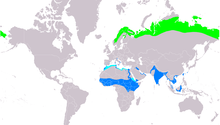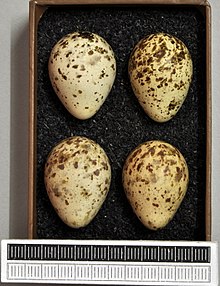Temminck sandpipers
| Temminck sandpipers | ||||||||
|---|---|---|---|---|---|---|---|---|

Temminck sandpipers |
||||||||
| Systematics | ||||||||
|
||||||||
| Scientific name | ||||||||
| Calidris temminckii | ||||||||
| ( Leisler , 1812) |
The Temminck sandpiper ( Calidris temminckii ) is a monotypical snipe bird; it is named after Coenraad Jacob Temminck . The bird that breeds in the tundras of Eurasia is a regular migrant in Central Europe at both migration times .
features
The Temminck sandpiper is 13.5 to 15 cm long and has a wingspan of 34 to 37 cm and a weight of 20 to 40 g. The bird is similar to the pygmy sandpiper , but has shorter legs and longer wings. The legs are yellow and the outer tail feathers are white. The plumage is rather plain with a brown top and a brown head and a white underside with the exception of a dark chest. He is not as sociable as other sandpipers and rarely forms large groups.
The downy cubs are white on the underside of the body and slightly yellowish beige on the throat. The skull and the top of the body are grayish beige with black, white and yellowish spots. The forehead and neck are pale yellow. There is a black central stripe on the forehead. There are black and narrow rein and eye stripes on the sides of the head. The iris is dark brown. The beak is initially flesh-colored shortly after hatching, but soon darkens to a blackish-gray. The legs and toes are brownish gray and claws dark gray.
distribution
The Temminck sandpiper breeds in bogs, swamps and estuaries in the arctic tundra of Eurasia. The breeding area extends from Scotland to Norway to northeast Siberia. The main areas of distribution include the Yamal south of the Yenisei river and the Taymyr peninsula .
The Temminck sandpiper is a distinct long-distance migrant. It winters on moderately overgrown silt banks of inland waters or on the coast in the Mediterranean area and south of the Sahara and South Asia. In autumn it moves across Asia and Europe on a broad front. Part of the population migrates individually, but small groups of two to five individuals are more typical. Birds breeding in Fennoscandinavia leave their breeding area from mid-July to late August. They move in a south-westerly or south-westerly direction across Europe and reach the Mediterranean region in September and early October. Re-discoveries of ringed birds show that the Scandinavian birds overwinter predominantly in West Africa, that the Temminck sandpipers that occasionally overwinter on the French Atlantic coast are also Scandinavian breeding birds and that there are important resting places in northern Italy. In contrast, the birds that breed in Western Siberia overwinter predominantly in southwest Asia and East Africa.
The Temminck sandpiper can be confused with the pygmy sandpiper. The most important distinguishing feature between these two species are the green-yellowish legs of the Temminck sandpiper.
habitat
The Temminck sandpiper is a breeding bird in the Arctic, but generally avoids the more extreme regions and exposed coasts there. Its breeding area extends far into the sub-arctic zone and the boreal zone.
Its habitats are relatively dry areas with low shrubbery. It mostly nests near small bays and fjords, estuaries and rivers. On the passage it can be found on more or less vegetation-free areas as well as in sparsely vegetated areas. He avoids sandy coasts if possible and stays mainly on the silty areas of protected bays and river mouths as well as salt marshes. Larger gatherings of Temminck sandpipers are also uncommon during migration times. Gatherings of 150 to 200 Temminck sandpipers, as they can happen at important resting places in Central Europe, are already unusual.
Reproduction
The males reach sexual maturity in the first year of life, females are sexually mature at one to three years. Similar to the pygmy sandpiper - albeit less regularly - the females show successive bigamy. They mate with two males one after the other. The first clutch is raised by the first male. The second clutch is looked after by the female.
The Temminck sandpiper incubates 3 - 4 eggs in a shallow hollow on the ground from May to July. Two clutches are created, one of which is incubated by the male and the second by the female. The young birds are cared for by the parent bird that hatched them. You are already fully fledged at 16 to 18 days and soon afterwards self-employed. A Temminck sandpiper, ringed as a dune young in southern Norway, was found in southern England at the age of 47 days.
food
It picks insects, worms, molluscs and crustaceans from the soft mud.
Duration
The European breeding population is between 85,000 and 420,000 breeding pairs. The majority of the European breeding population breed in the European part of Russia (75,000 to 400,000 breeding pairs) and in Fennoscandinavia (9,500 to 18,500 breeding pairs). The Temminck sandpiper is one of the species for which it is forecast that the expected global warming will have a significant impact on the range. A research team, which, on behalf of the British environmental authority and the RSPB, examined the future development of the distribution of European breeding birds on the basis of climate models, assumes that two thirds of the current range will no longer offer suitable habitats for this species by the end of the 21st century. The loss of land is particularly clear in Finland. Novaya Zemlya as well as Spitzbergen and Franz-Josef-Land may offer new suitable habitats . However, this area expansion in the north cannot compensate for the loss of area further south.
supporting documents
literature
- Hans-Günther Bauer, Einhard Bezzel and Wolfgang Fiedler (eds.): The compendium of birds in Central Europe: Everything about biology, endangerment and protection. Volume 1: Nonpasseriformes - non-sparrow birds. Aula-Verlag Wiebelsheim, Wiesbaden 2005, ISBN 3-89104-647-2 .
- Collin Harrison and Peter Castell: Fledglings, Eggs and Nests of Birds in Europe, North Africa and the Middle East. Aula Verlag, Wiebelsheim 2004, ISBN 3-89104-685-5
- Simon Delany, Derek Scott, Tim Dodman, David Stroud (Eds.): An Atlas of Wader Populations in Africa and Western Eurasia. Wetlands International , Wageningen 2009, ISBN 978-90-5882-047-1 .
- Richard Sale: A Complete Guide to Arctic Wildlife , published by Christopher Helm, London 2006, ISBN 0-7136-7039-8
Web links
- Calidris temminckii in the endangered Red List species the IUCN 2008. Posted by: BirdLife International, 2008. Accessed January 31 of 2009.
- Videos, photos and sound recordings of Calidris temminckii in the Internet Bird Collection
- Temminck sandpiper's feathers
Single receipts
- ^ Harrison et al., P. 138
- ↑ Delany et al. P. 380
- ↑ Delany et al., P. 380
- ↑ Delany et al., P. 382
- ↑ Sale, p. 196
- ↑ Delany et al., P. 383
- ↑ Delany et al. P. 383
- ↑ Bauer et al., P. 533
- ^ Harrison et al., P. 138
- ↑ Delany et al., P. 380
- ↑ Bauer et al., P. 532
- ^ Brian Huntley, Rhys E. Green, Yvonne C. Collingham, Stephen G. Willis: A Climatic Atlas of European Breeding Birds , Durham University, The RSPB and Lynx Editions, Barcelona 2007, ISBN 978-84-96553-14-9 , P. 181



